“Ethylene" is a plant hormone found in rubber, playing a role in root development and participating in latex vessel operation. It stimulates latex production, facilitating a slower coagulation process, and resulting in a more viscous latex flow. Scientists have devised various methods to supplement ethylene into the plant stem based on these properties. The most common method is applying on a splitting mouth (ethephon absorbed by the tree releases ethylene), which is widely used by farmers. In Vietnam, Ethephon goes by several trade names such as Adephone 2.5Paste, Callel 2.5Paste, Forgrow 2.5Paste, Sagolatex 2.5PA...".
However, that method has many limitations such as: creating acids and substances that affect the plant, making it susceptible to mouth rot, degeneration of the pus glands, and dryness of the plant when exposed to rain or humidity. Reference Tham khảo link
Cách đây 20 năm, Malaysia đã ứng dụng bơm khí Ethylene vào thân cây để làm chậm quá trình đông mủ, giúp mủ ra nhiều hơn. Twenty years ago, Malaysia began using Ethylene ethylene gas injection into the plant stem to slow down the latex coagulation process, resulting in increased latex production. Vietnamese farms experimented with and adopted this technology (ETHYLENE GAS TECH, RRIMFLOW) in 2008. However, the application of the traditional method faced challenges and high material costs, leading to a decline in widespread adoption after a decrease in latex prices. In the private sector, successful applications have been notable, with Hoang Anh Gia Lai being the most prominent. Since 2012, they have successfully employed the RRIMFLOW method, using small mouth-swabbing to exploit thousands of hectares in Laos, aiming to save labor costs 2-3 times and address the labor shortage in latex tapping. Reference. Tham khảo link.
In the past 8 years, the latex tapping method of drilling has begun to develop in Thailand. A series of compact and convenient pneumatic tools have been designed, combined with the use of plastic tubes ranging from 2 to 6 mm in diameter to allow latex to flow for an extended period. The Thai government has sponsored research projects, demonstrating that the pneumatic method stimulates 99% ethylene release. Among the two latex tapping methods, drilling (or poking) with small droplet tubes and 1/6S scraping according to D3 yield the best results in all latex tapping methods to date, including traditional D2 scraping. This method does not affect the rubber tree's development.
Due to the very slow and specific duration of latex flow, the rubber tree not only remains unaffected but also thrives. It doesn't lose its bark and yields better quality wood in the long run. Latex tapping using this method results in slower leaf shedding compared to traditional scraping, quicker leaf growth, and extends the tapping period by over 40 years with superior productivity. Additionally, the extended latex tapping time allows farmers to drill, poke, or use 1/6S small droplet tubes to collect latex in the afternoon or early morning, making the work simpler and lighter, without the need for nighttime work. Combining nylon rain covers or rain caps with regulated latex tapping (typically 20-100% depending on the tree's age) following D3-D5 standards will increase latex production, helping farmers increase profits. Importantly, this method can be used for long-term latex tapping on drought-prone trees and can restore latex productivity in orchards with poor latex flow due to rapid coagulation.
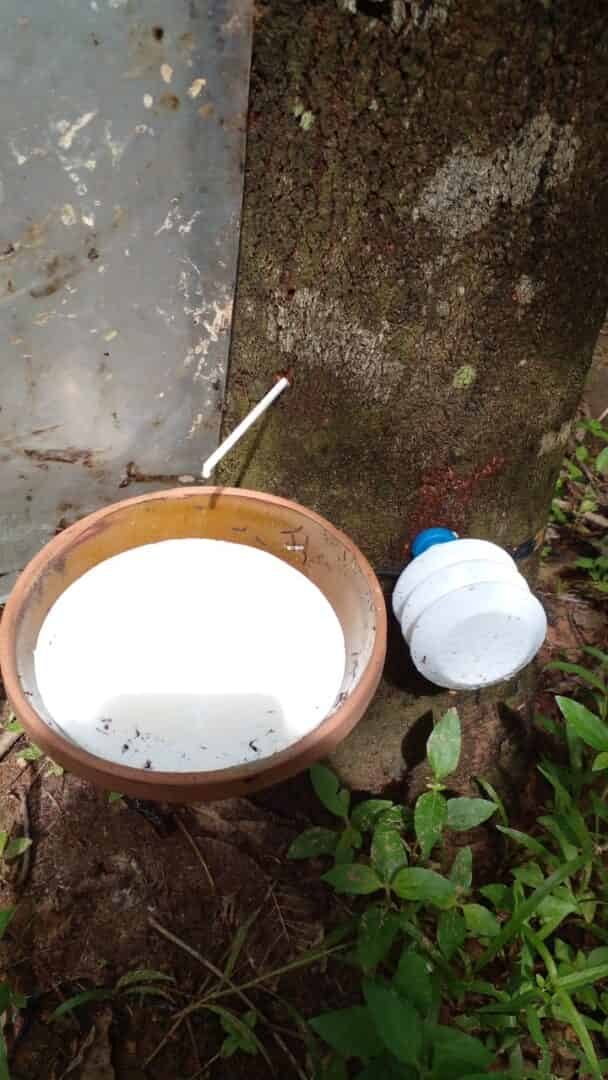
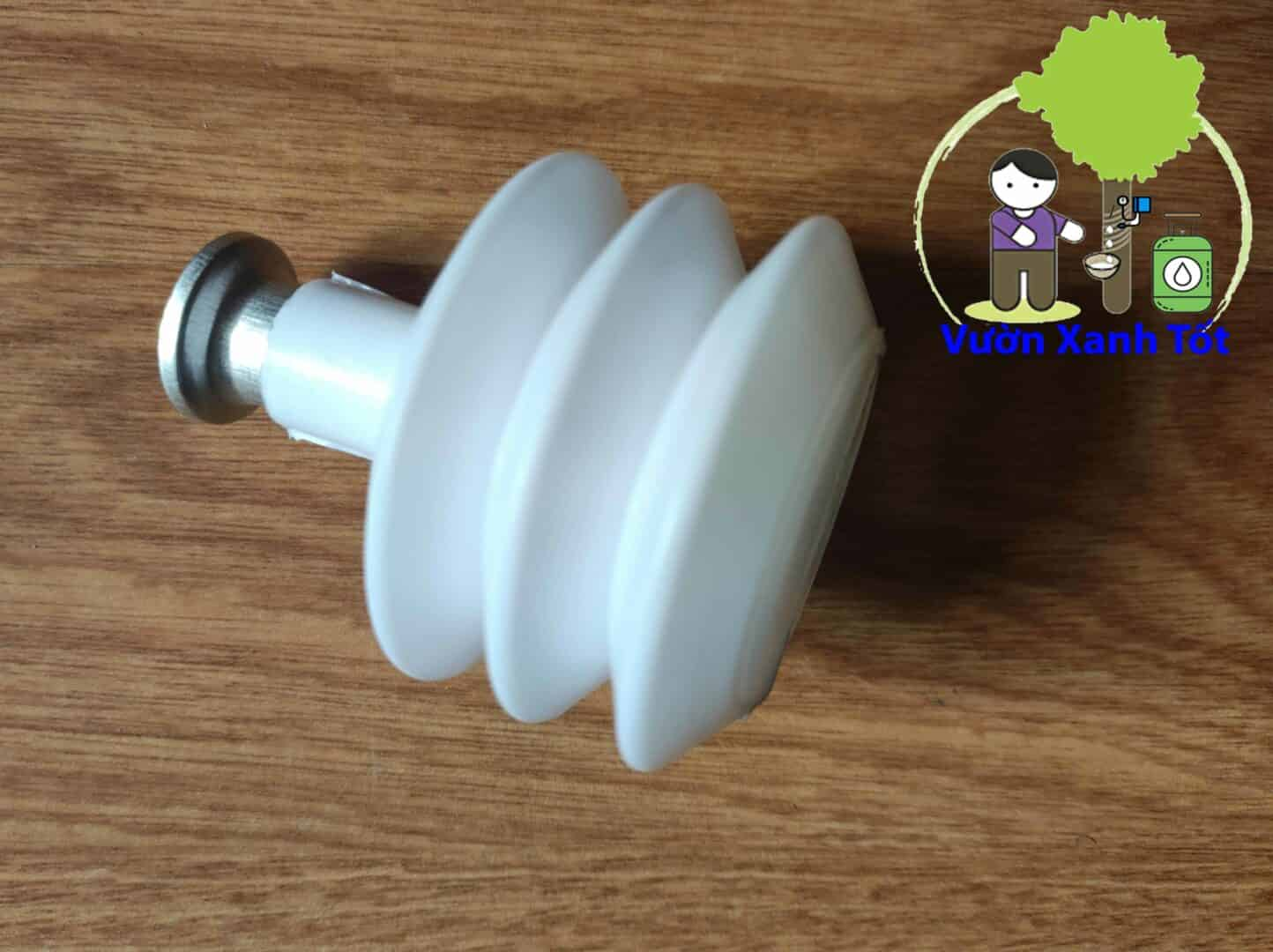
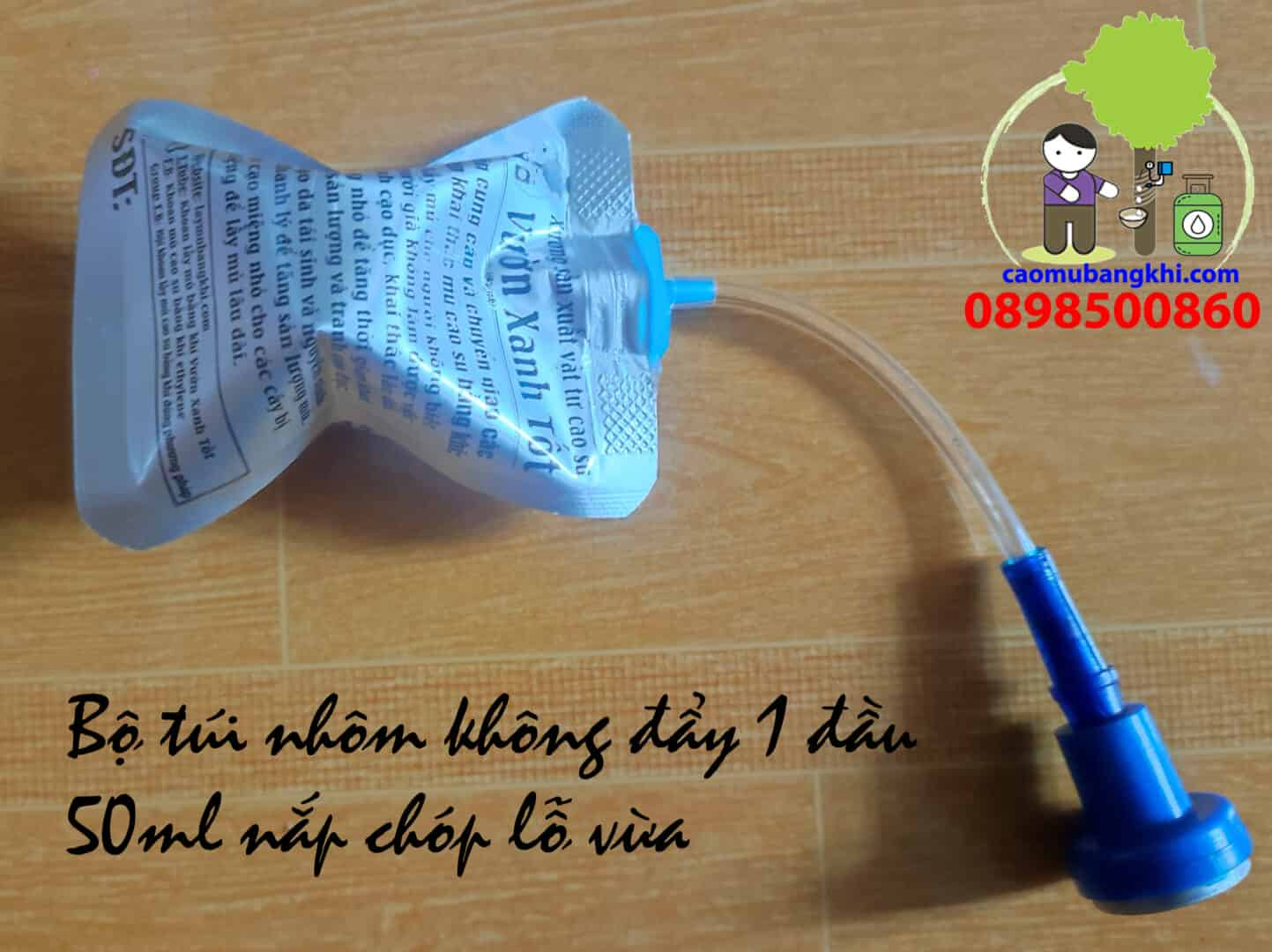
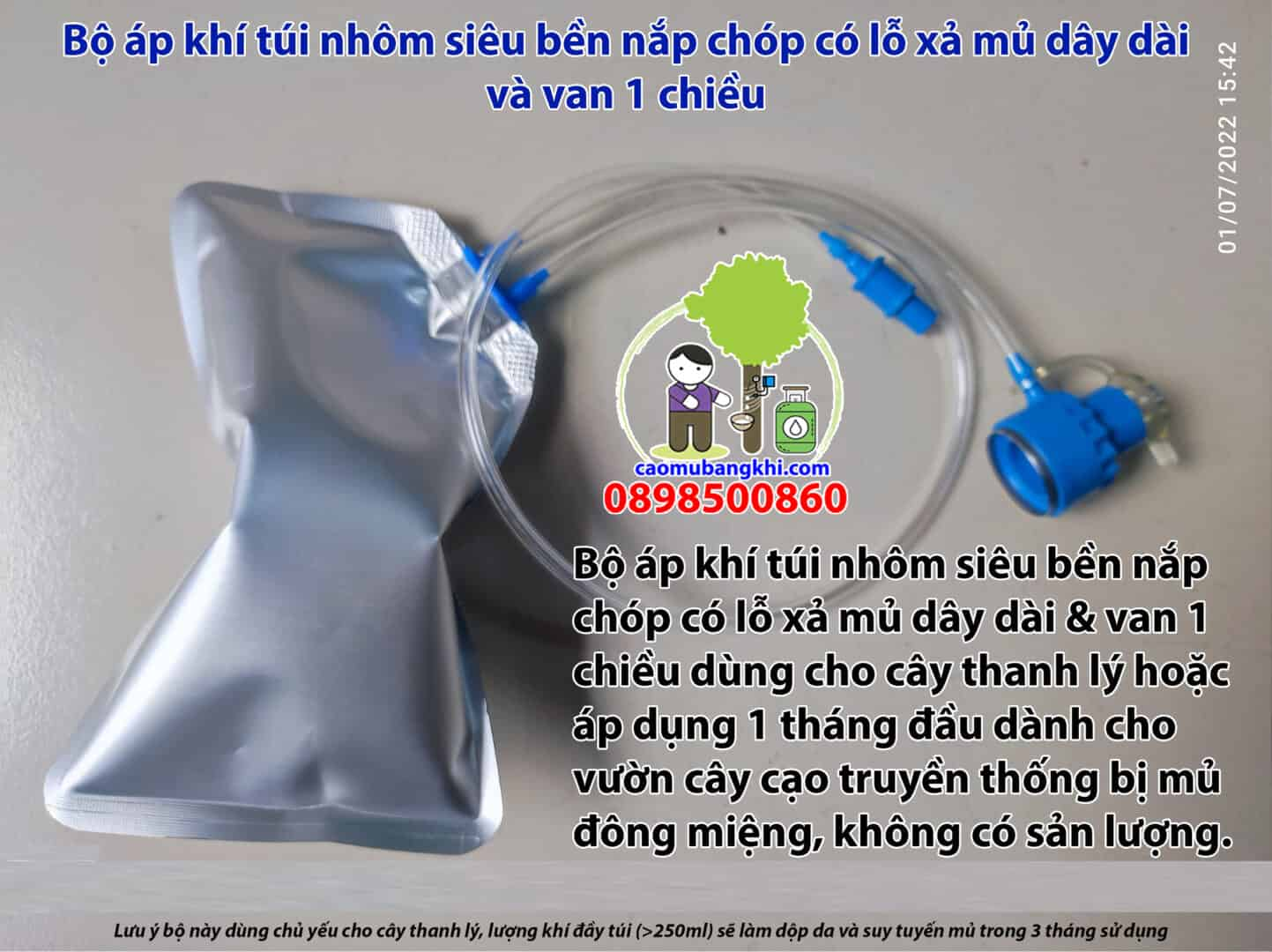
After a period of learning, the company "Vườn Xanh Tốt" has produced a set of pneumatic tools in Vietnam with stainless steel rings that are twice as thick as the tin-plated iron rings from Thailand. This has extended the usage time and reduced the cost to only one-third of the Thai products. Additionally, "Vườn Xanh Tốt" has designed and provided customizable pumping tools, which allow precise ethylene gas pumping with simple and efficient operations. This helps save ethylene gas costs, ensures stable latex production, and enables safe tapping without harming the trees. It not only maintains the tree's health but also supports its development along with proper fertilization. Importantly, it avoids situations where excessive ethylene gas harms the trees and is detrimental to their growth.
"Vườn Xanh Tốt" is the first company to develop and introduce ethylene gasless tapping bags in the market. These ethylene gasless tapping bags come in various sizes, ranging from 45ml to 90ml, suitable for all types of rubber plantations. With the characteristic feature of "no ethylene gas pushing, but allowing the tree to exchange an appropriate amount of ethylene gas," these ethylene gasless tapping bags have shown excellent results after 3 years of testing. They ensure consistent latex collection, maintain stability, reduce variations between tapping sessions, and are easy to regulate. They minimize the risk of bark damage and latex depletion, enabling long-term and sustainable latex tapping in rubber plantations.
Furthermore, after 5 years of development, research, and statistics, "Vườn Xanh Tốt" has released a comprehensive instructional video series detailing the pneumatic drilling and small droplet tube tapping methods for various types of rubber trees. This initiative aims to provide everyone with access to the correct techniques, ensuring long-lasting effectiveness.
If you are interested in learning more about these methods, you can visit the "Vườn Xanh Tốt" office at the Science and Technology Center in Binh Phuoc Province, Dong Xoai City.
The instructional video series on rubber latex tapping methods by "Vườn Xanh Tốt" includes:
"Vườn Xanh Tốt" rubber tree plantation using the pneumatic drilling method after 6 years of use.
"Vườn Xanh Tốt" rubber tree plantation using the short tapping method after 5 years of use.
The ethylene ethylene gas tapping method for rubber latex must be executed correctly according to the "Vườn Xanh Tốt" approach to achieve good and long-lasting results. Some companies in the market offer bags with a high ethylene gas capacity to attract users, who intend to collect large amounts of latex early in the season. However, these large bags are challenging to regulate and should only be used for clearance sales. Therefore, many farmers mistakenly use inappropriate bags, resulting in reduced latex production and rubber tree depletion by the second or third year, leading to plantations being abandoned.
"Vườn Xanh Tốt" offers a wide range of pneumatic tool kits with capacities ranging from 45ml to 200ml, suitable for various types of rubber tree plantations. These kits help regulate latex and ethylene gas levels effectively, minimizing ethylene gas surplus and latex gland aging, and allowing farmers to tap latex sustainably and efficiently over the long term.
The non-inflatable bags with capacities ranging from 45ml to 70ml are used for long-term latex tapping:

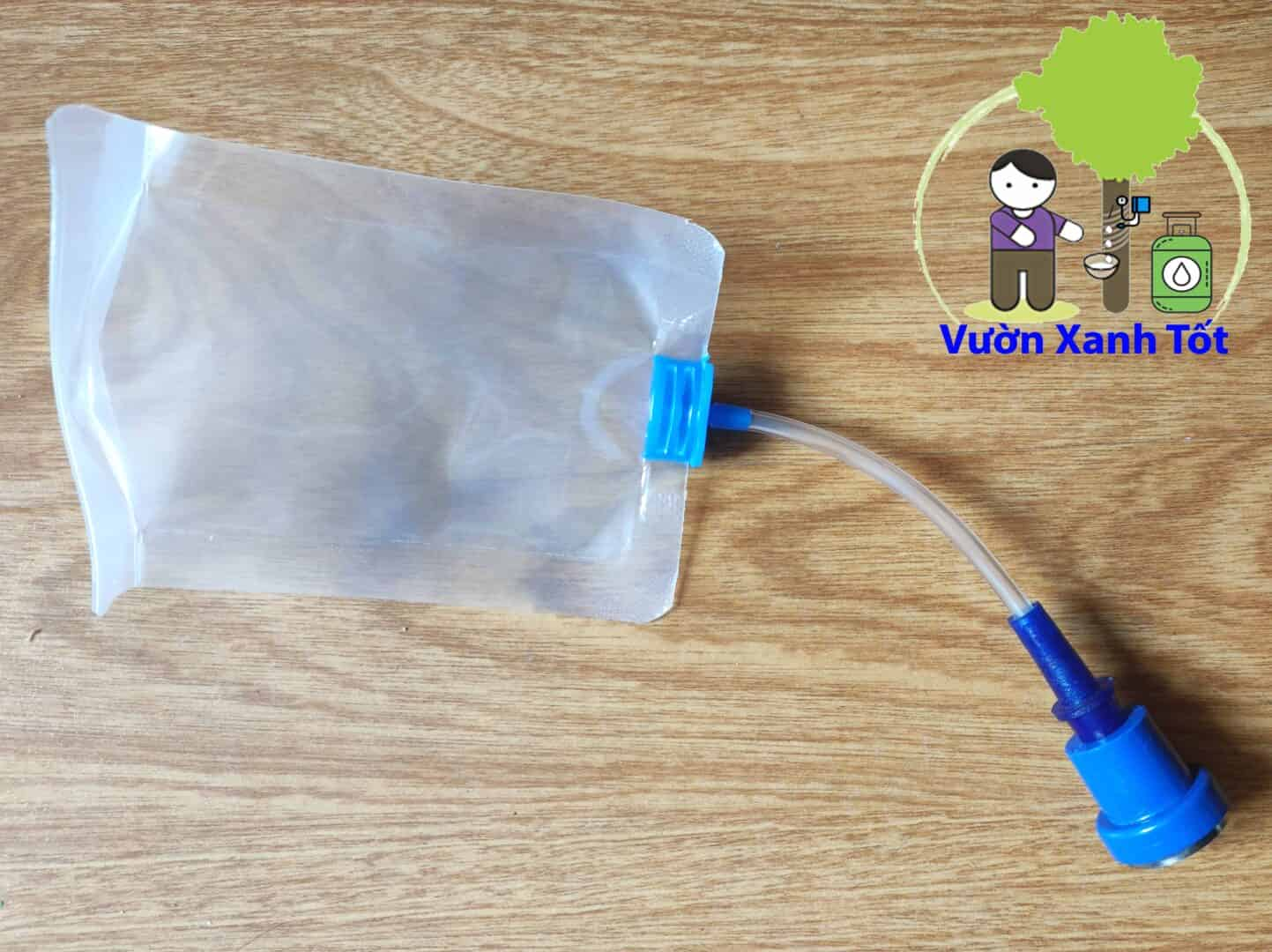

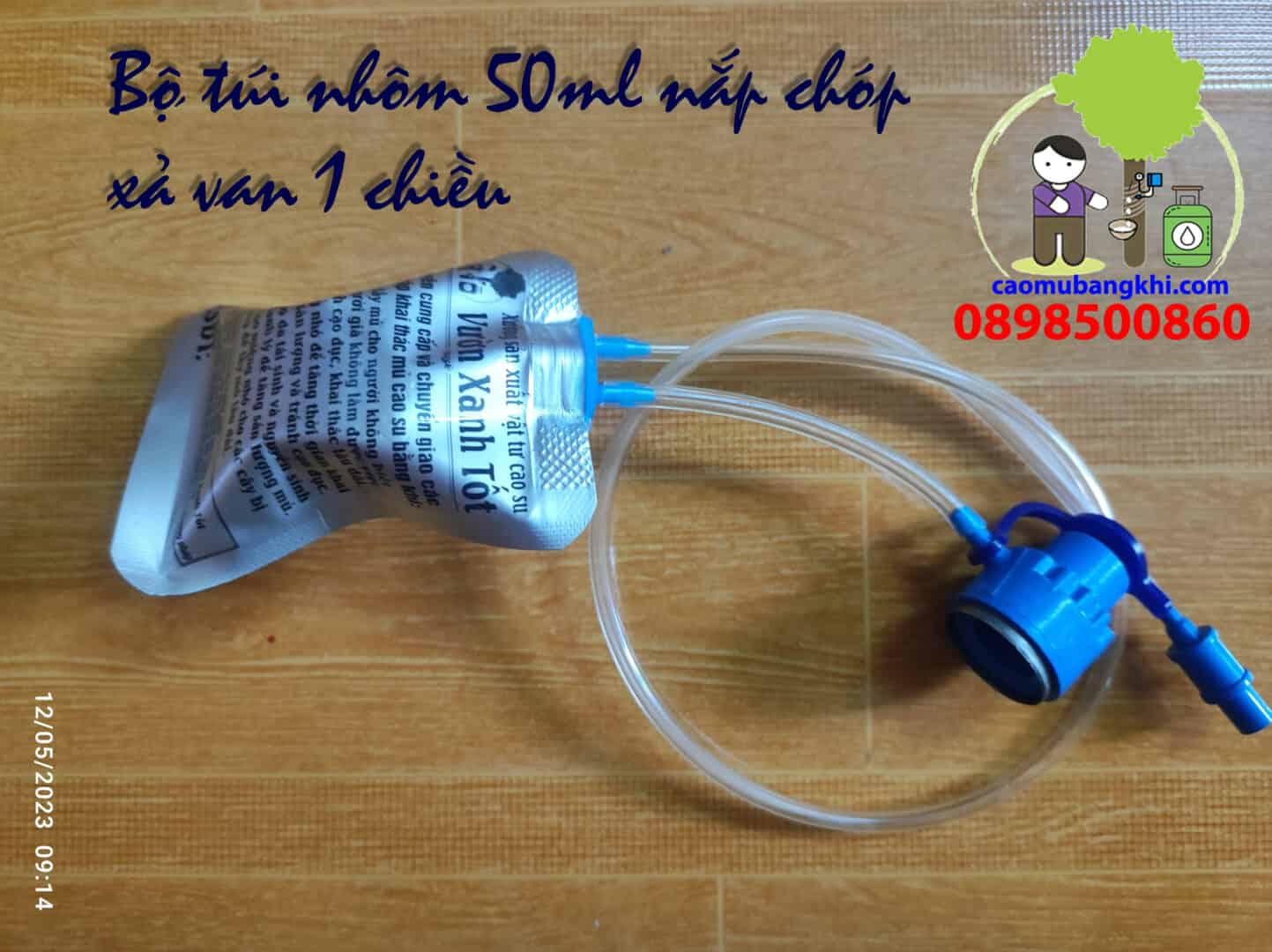
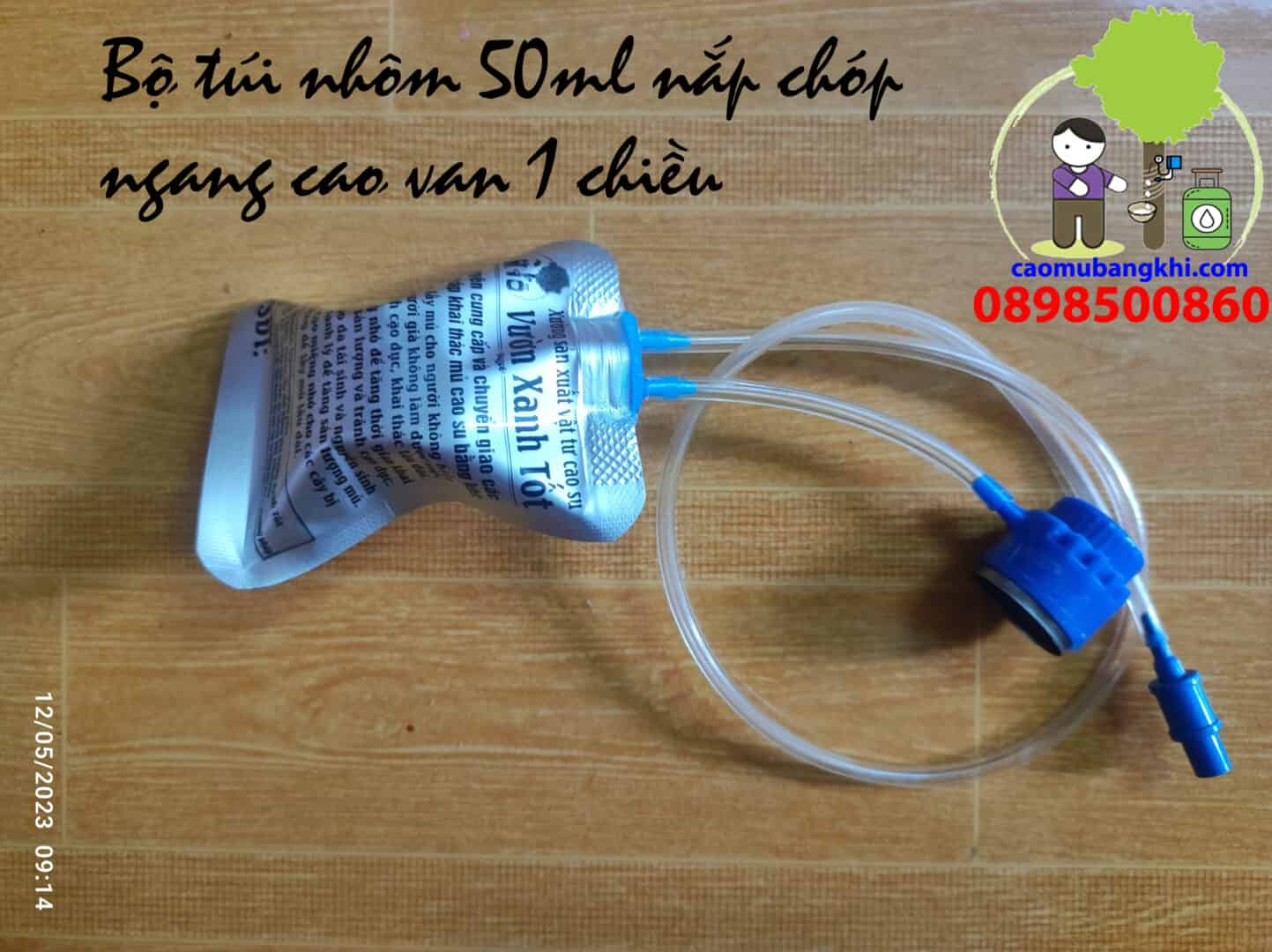
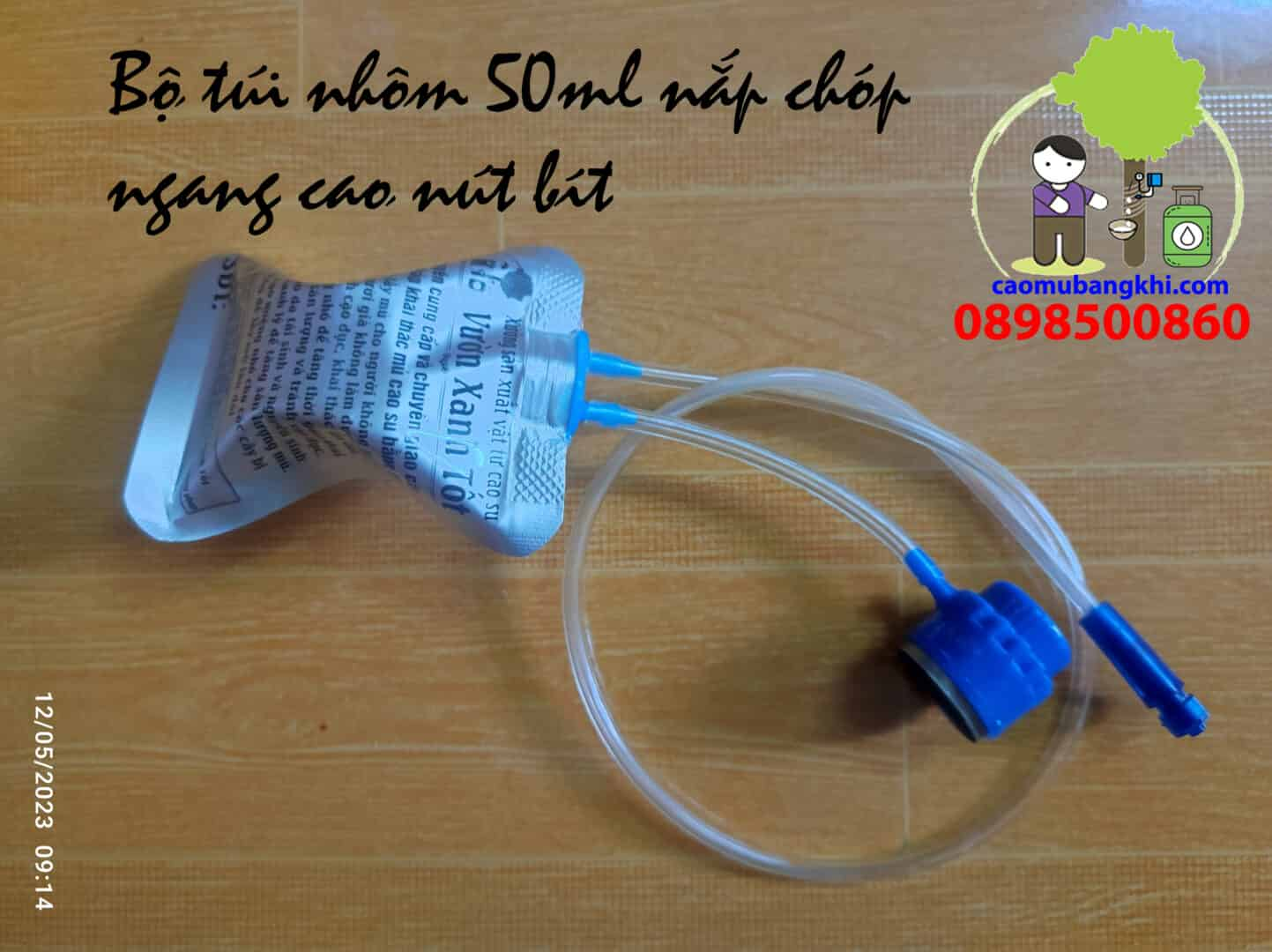
The 200ml bags are intended for clearance purposes within 1-3 years:

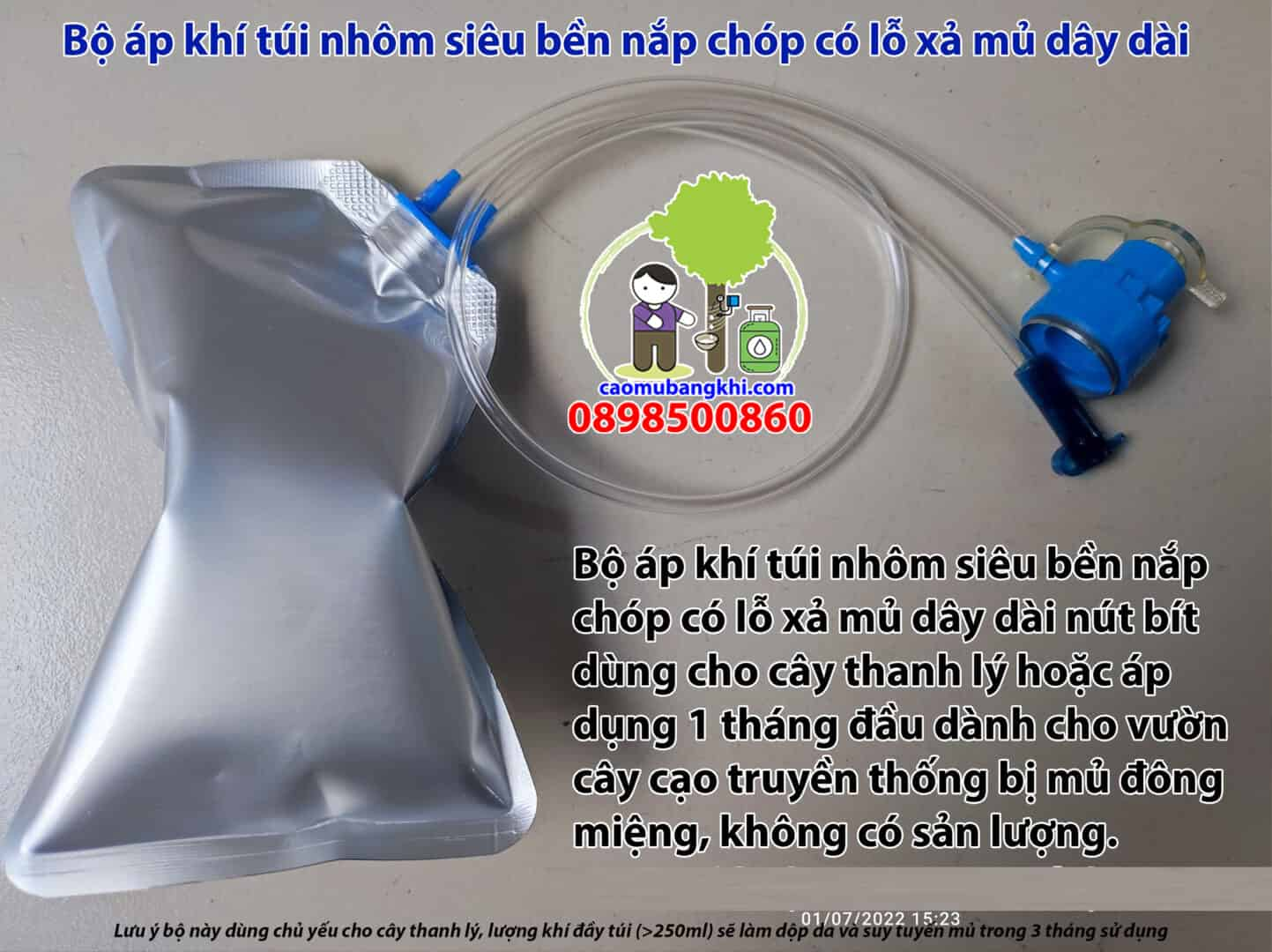
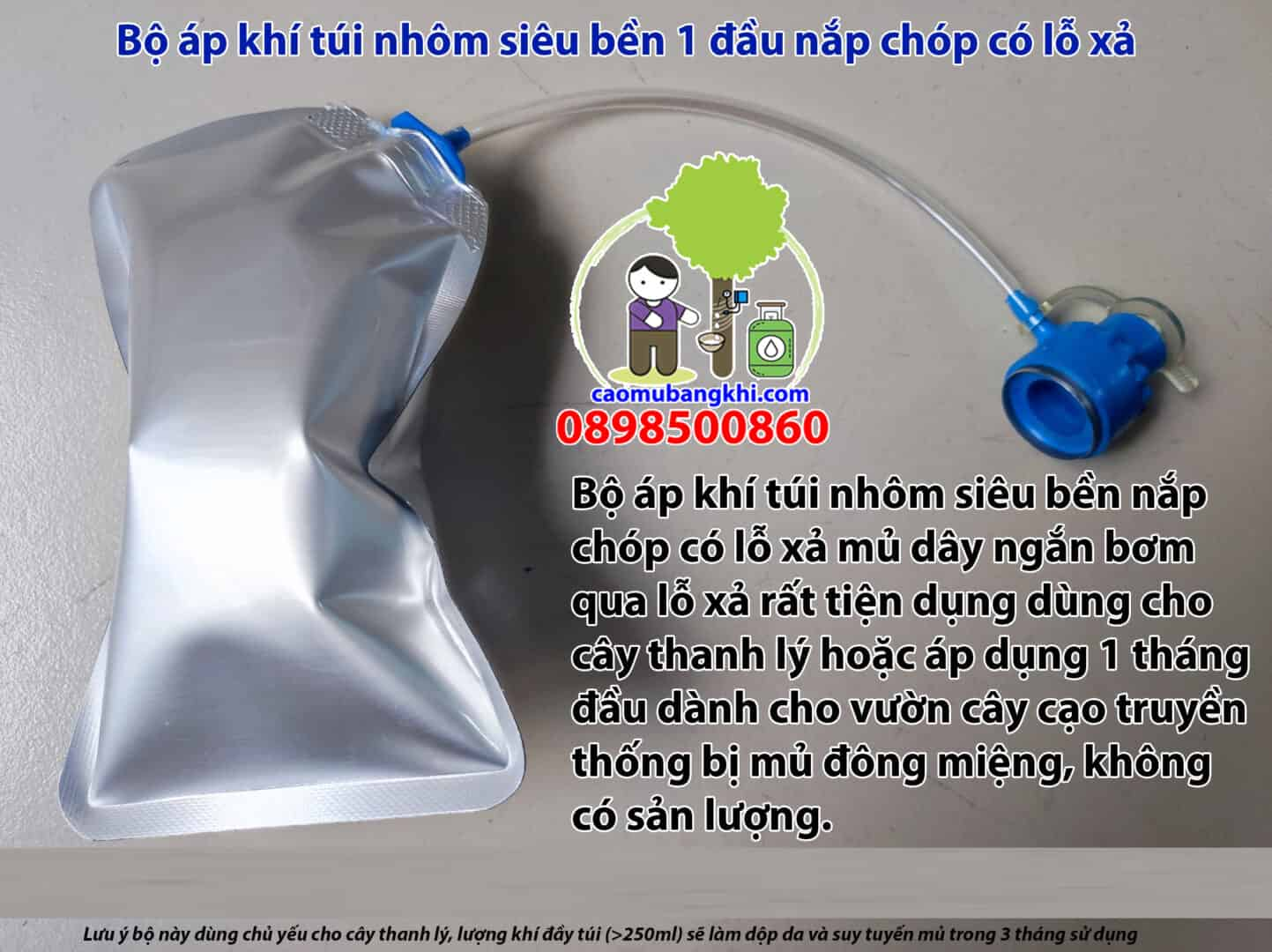
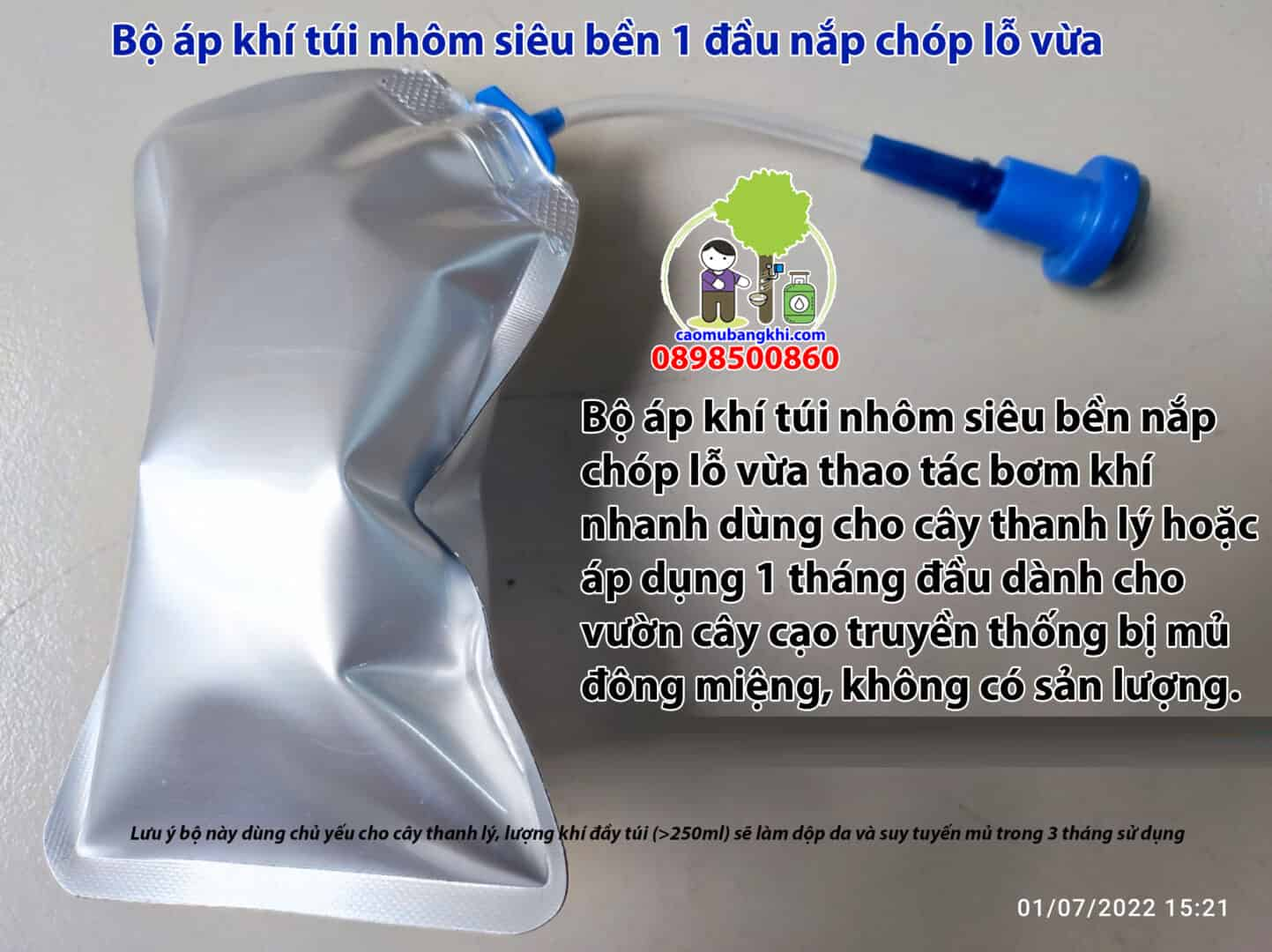
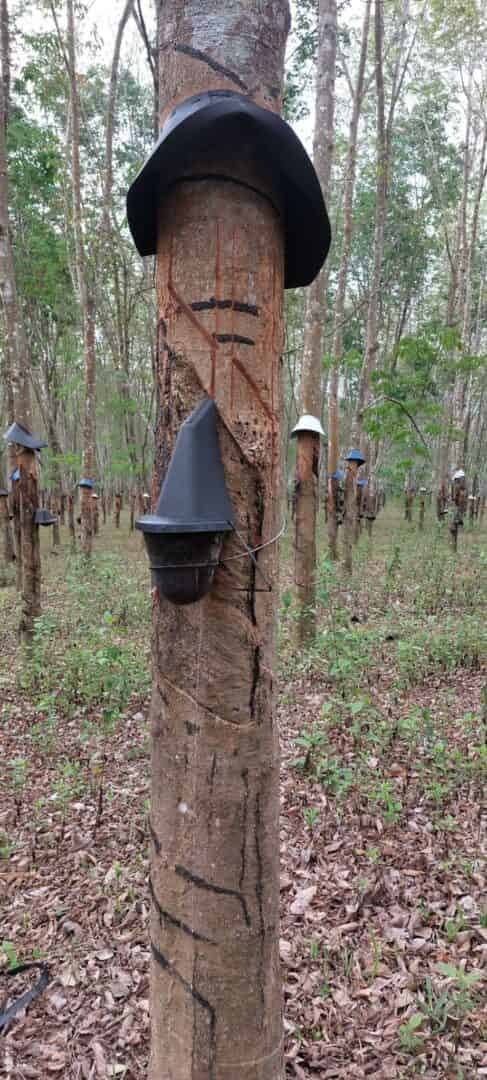
Why can't the 200ml bags be used for long-term tapping and only serve for clearance (3 months to 3 years)? ![]() .
.
Firstly:
As everyone knows, ethylene gas is also a form of mouth-swabbing scraping. When mouth-swabbing medication permeates the latex vessels, it releases ethylene ethylene gas and two types of acids (as seen in the reaction below). Ethylene is the primary factor that helps the latex flow more viscously. Therefore, using a high concentration of medication above 2.5 and applying it excessively will exhaust the tree, reduce vigor, and damage the latex vessels, leading to dry tapping.
Hence, the dosage of ethylene ethylene gas plays an extremely crucial role in long-term latex tapping. From the chemical formula and the reaction with water, we can calculate that applying ethephon with a concentration of 2.5 is equivalent to 60 ml of ethylene gas. Therefore, the safe dosage for the tree should be below 50ml of ethylene gas, depending on the age of the tree.
Therefore, the safe volume of the bag for the tree should be below 50ml to limit the misuse of ethylene gas, which can affect both the latex vessels and the long-term productivity of the tree. The exemplary plantations that actively adhere to the ethylene gas reduction rule maintain high yields in subsequent years, and the latex vessels remain unaffected (possibly with a slight thinning of the bark due to thicker skin).
According to statistical data, plantations using bags of 200ml or more for long-term latex tapping experience reduced latex production, and by the third year, they are either cleared or switched to a new long-mouth tapping method to achieve sufficient productivity."
Secondly: Ethylene gas concentration when using clearance bags
In practical applications of the pneumatic method, different trees in the plantation have varying rates of ethylene gas emission. For example, after pumping 1/3 of the bag, within 3-4 days, many trees show the bag expanding due to excessive ethylene gas emission, while others may deflate the ethylene gas bag.
Therefore, when pumping an appropriately measured amount of ethylene gas (usually under 60ml) into the bag, some trees emit excessive ethylene gas into the bag (due to the bag's large volume), leading to a diluted ethylene gas concentration inside the bag. Consequently, ethylene gas permeation into the trees is much less than in trees emitting less ethylene gas. This results in varying yields, with some trees producing more and others less, leading to inconsistent latex production. The latex may coagulate (as high-altitude latex tends to coagulate quickly), prompting farmers to increase ethylene gas. This causes disturbance in latex tapping across the plantation, with some trees struggling to absorb ethylene gas. This misuse of ethylene gas can lead to long-term rubber tree depletion and bark peeling.
On the other hand, the 50ml bags, combined with the non-pushing feature, maintain a consistently high ethylene gas concentration. Trees can only push a small amount of excess ethylene gas into the bag (due to the limited 50ml capacity), and with the small volume, ethylene gas exchange is consistently above 95% for all trees in the plantation. This helps stabilize latex production, making ethylene gas reduction more manageable. It is easier to regulate latex volume, and for only a few smaller trees struggling to handle the latex flow, a single round of ethylene gas pumping adjustment is usually sufficient.
The aluminum bag series for clearance with capacities of 200ml-250ml:

Ten to twenty years ago, in Vietnam, ethylene with a low purity of 60% was used, along with various impurities extracted from kerosene at a low cost (only 1/10th of the price of pure 99.95% ethylene). It was applied to trees to stimulate latex, and trees were often cleared within less than 6 months.
This 60% ethylene contained many harmful impurities for the trees, and excessive pumping of ethylene gas over large ethylene gas areas without changing the location, tapping a continuous large amount of latex, would affect the trees after only 3 months, causing reduced latex production, known as dry tapping. Therefore, the image of ethylene during that time became harmful.
Hence, it is advised not to use ethylene ethylene gas with an unclear origin, as it poses a danger to the trees. "Vườn Xanh Tốt" company provides ethylene ethylene gas with a purity of 99.95%, imported from reputable and large partners, completely free of harmful impurities for the trees. Công ty Vườn Xanh Tốt cung cấp khí gas Ethylene với độ tinh khiết 99.95% được nhập khẩu từ đối tác lớn, uy tin, hoàn toàn không chứa các khí tạp chất có hại cho cây.
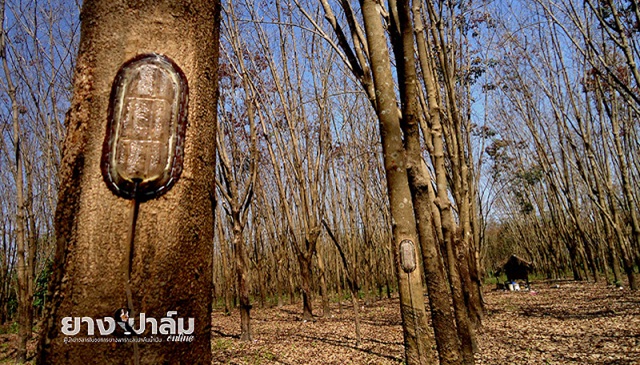
Images of the RRIMFLOW ethylene ethylene gas covering method from Malaysia
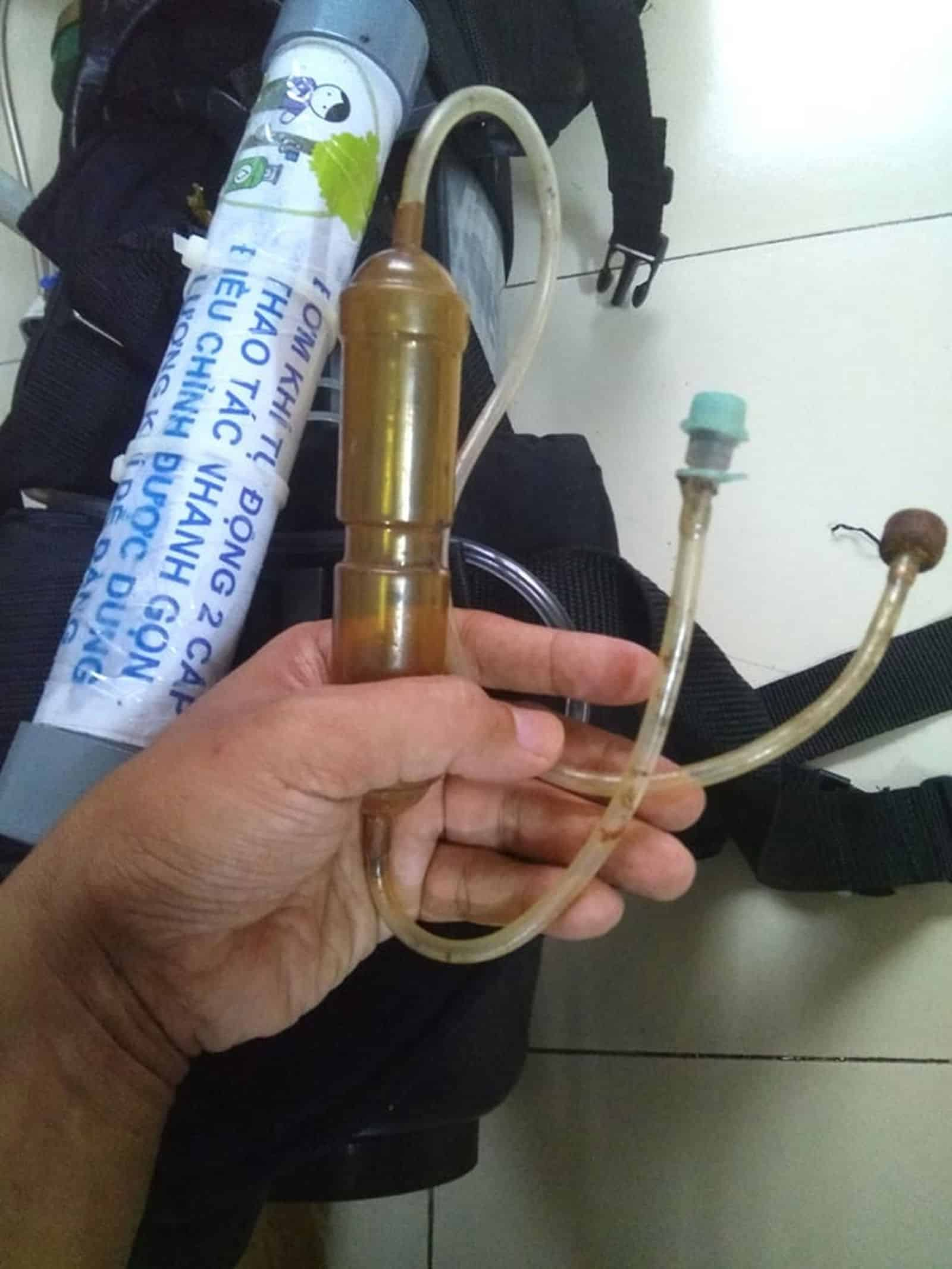
The ETHYLENE GAS TECH pneumatic tool kit, currently being used by Vietnamese rubber plantations for clearance tapping, has replaced the mouth-swabbing method.
In the past eight years, the drilling or tapping method for latex extraction has started to develop in Thailand, under the investment and support of the government. A series of latex-permeating tools with compact and convenient designs have emerged, combined with the use of small-diameter plastic tubes with holes of 1.5mm. This setup facilitates continuous latex flow for 10-14 hours. Thanks to the slow and controlled latex flow over an extended period and the precise stoppage of flow at specific times, the trees not only remain unaffected but also thrive. The latex tapping method ensures minimal bark damage and excellent wood quality for the future. Moreover, the prolonged latex tapping period allows farmers to collect latex in the afternoon and discharge it in the morning, making the process simpler and lighter, eliminating the need to work at night."
Về phương pháp này, chính phủ Thái đã tài trợ cho các dự án về phương pháp khoan và bơm khí kích thích ethylene 99%. Các nghiên cứu đã chứng minh được rằng phương pháp áp khí kích thích (hormone) ethylene 99% cho 2 cách lấy mủ là chọt (khoan) chảy ống nhỏ giọt và cạo 1/6S theo D3 cho kết quả tốt nhất trong tất cả các phương pháp lấy mủ từ trước đến nay, kể cả cạo theo D2. Và không ảnh hưởng đến sự phát triễn của cây cao su.
Đây là báo cáo khoa học của đại học Songkla do nhà nước tài trợ kinh phí 2015-2016:
การเพิ่มประสิทธิภาพการกรีดยางพาราโดยใช้แก๊สเอทธิลีนภายใต้ความแปรปรวนของ
ภูมิอากาศในภาคใต้ของประเทศไทย
Enhancing the Rubber Tapping Efficiency Using Ethylene Stimulation
under Climate Variability in Southern Thailand
Tối ưu hóa khai thác mủ cao su bằng khí ethylene dưới các điều kiện thời tiết tại miền nam Thái Lan
Báo cáo khoa học khá dài, mình đang dịch từ từ nên các bạn vui lòng down về và xem theo link sau:
Cùng với bộ che mưa và lấy trực tiếp từ ống đến chén, phương pháp này còn giúp khai thác mủ đều đặn vào các ngày mưa, lượng mủ thu được nhiều hơn 50% giúp tăng hơn gấp đôi năng suất mủ. Thu nhập nhiều hơn và thời gian hoàn vốn rất nhanh.
Điều đó lý giải tại sao, các quốc gia có thu nhập cao hơn gấp từ 2 đến 5 lần Việt Nam mà vẫn có thể khai thác cao su trong giai đoạn giá rẻ hiện nay. Đó chính là nhờ phương pháp này.
Về vấn đều phân bón cho cây khi áp dụng phương pháp này, để tăng lượng mủ lên 50% thì chúng ta cần tăng lượng phân, bón nhiều lần và trãi đều trong năm, và nhất là phải cung cấp đủ nước cho cây. Tốt nhất trong vườn cây, chúng ta nên trồng hoặc để cỏ phủ đầy để giúp đất tránh sói mòn và đồng thời giữ được độ ẩm và nước trong đất ở những ngày nắng. Ngoài ra cỏ còn tổng hợp đạm từ không khí và bổ xung dinh dưỡng cho đất.
Vấn đề chi phí thiết bị: hiện nay hàng nhập khẩu từ Thái Lan và Maylaysia chi phí vận chuyển khá đắt, nhất là vận chuyển gas, phải đóng kiện gỗ rất nặng, làm tăng chi phí rất nhiều. 1 bộ bơm khí chất lượng bán lẻ tại Thái có giá 30-50 baht ( 20.000 – 36.000), khi vận chuyển qua VN giá tăng tầm 25 – 41.000. Với giá như thế và chi phí đắt đỏ về gas cũng như vận chuyển gas đã tạo nên 1 lực cản rất lớn cho người nông dân để đầu tư.
Ngoài ra vấn đề lớn của phương pháp kích thích khí ethylene là làm cách nào khống chế được lượng mủ chảy ra ổn định, theo định mức, để không làm ảnh hưởng cây. Và Vườn Xanh Tốt đã tạo ra bơm định lượng để dễ dàng điều khiển được lượng mủ lấy ra bằng các tùy chỉnh lượng khí phù hợp, đảm bảo độ mủ không giảm để không vượt quá sức tạo mủ của cây.
Vì vậy sau khi khảo sát khả năng tài chính cũng như nhu cầu của người trồng cao su, Caomubangkhi.com đã quyết định sản xuất tại VN nhằm giảm thiểu tối đa chi phí, chủ động nhập khẩu gas từ nhà máy. Sau 3 tháng triển khai sản xuất, Caomubangkhi.com đã giảm giá thành sản phẩm xuống gần 2.5 lần (sản phẩm giá rẻ chỉ còn 10.000 1 bộ, chi phí gas 1 lần bơm chỉ 50 đồng). Từ đó người dân dễ dàng tiếp cận hơn, gia tăng năng suất để có thể cạnh tranh với các nước xung quanh khu vực.
Sau đây là diễn giải chi tiết hơn về quá trình hình thành cũng như ứng dụng ethylene với cây cao su:
Phương pháp dùng khí Ethylene được giới thiệu trong ngành công nghiệp cao su từ những năm đầu 1990, và được áp dụng rộng rãi vì hiệu quả, an toàn, tiết kiệm chi phí. Phương pháp này dựa vào cách ứng chế sự đông mủ vết thương ở bề mặt vết cắt. Nó giúp kéo dài thời gian chảy mủ và tăng sản lượng cao su thu hoạch. Ngoài ra nó còn kết hợp với cách khoan lấy mủ, giúp người lấy mủ có thể làm việc vào ban ngày, đơn giản hóa lao động, không cần bất cứ kinh nghiệm nào, tận dụng được mọi lao động nhàn rỗi trong cộng đồng.
Từ đầu những năm 2000, các nông trường Việt Nam bắt đầu chuyển giao công nghệ RF (RIMFLOW) và GT (GAS TECH) từ Malaysia. Tuy nhiên với chi phí đầu tư cao, cộng với lấy mủ quá nhiều không kiểm soát đã khiến nhiều cây kiệt mủ. Vì thế đến nay nông trường chỉ dùng phương pháp này để kích thích mủ dành cho cây thanh lý.
Nguyên lý và Phương pháp :
Điểm chính yếu của phương pháp này là hấp thụ khí Ethylene vào cây thông qua ống tiêm cắm vào lớp da cây. Sau đó có thể kết hợp nhiều phương pháp lấy mủ như: khoan lỗ lấy mủ từ ống nhựa theo nhịp độ 1 ngày lấy 2 ngày nghĩ, hoặc theo cách cạo truyền thống với vết cạo nhỏ từ 5cm đến 10cm (1/4S đến 1/8S) theo nhịp độ cạo D3, D4. Sau khi tiêm khí, cây sẽ cho mủ liên tục 9 ngày, cho số lượng mủ lớn, giúp giảm công đi thu mủ.
Ngoài ra nếu dùng cách thu mủ bằng ống và có máng che chén thì sẽ thu hoạch liên tục trong mùa mưa, ở mọi điều kiện thời tiết, giảm chi phí che chắn, giữ năng suất lao động công nhân (trời mưa vẫn đi thu hoạch mủ và tiêm khí vào bình chứa).
Phương pháp lấy mủ này kết hợp với liệu trình lấy mủ hợp lý giúp cây giữ được lớp da cây, cây sinh trưởng tốt, ít bệnh và năng suất mủ tăng, kéo dài thời gian khai thác hơn cách truyền thống nhiều năm, gia tăng tuổi thọ cây cao su từ 50-60 năm.
Quá trình phát triển của phương pháp khích thích khí ethylene và khoan lấy mủ:
Như chúng ta đã biết, con người đã biết khai thác mủ cao su và ứng dụng vào cuộc sống từ hàng trăm năm trước. Trong quá trình khai thác mủ, dựa vào kinh nghiệm kết hợp tìm tòi khám phá mà chúng ta đã có những bước tiến trong việc cải thiện chất lượng và số lượng mủ, theo trình tự thời gian như sau:
– Năm 1912: Camerun phát hiện ra rằng hỗn hợp dưa chuột và đất sét giúp tăng sản lượng cao su.
– Năm 1951: Tixier phát hiện ra rằng vàng hoặc CuSo4 chôn cạnh gốc, làm tăng sản lượng cao su trong 3 tháng, và GW Chapman thấy rằng dầu cọ pha trộn 2,4-D quét miệng sẽ làm tăng sản lượng mủ.
– Năm 1961: nhận thấy rằng Ethylene Oxide giúp gia tăng lượng mủ.
– Năm 1964: nhà khoa học Nga đã tạo được Ethephon từ Ethane, và nó có thể làm tăng lượng mủ.
– Công ty Union Carbide năm 1965 Sản xuất Ethephon với mục đích thương mại, còn gọi là Ethrel.
– Năm 1968, Bonner thử nghiệm lớp phủ nhựa. Với sự có mặt của khí ethylene, sản lượng mủ đã tăng đáng kể.
– 1994: Các phương pháp bơm trực tiếp khí Ethylen vào cây đã được thử nghiệm ở nhiều nơi.
– Và được áp dụng từ năm 2000, thí điểm nhiều ở Malaysia, tại Thái Lan từ năm 2012 và ứng dụng rộng rãi cho đến nay.
Năm 2008, các nông trường tại Việt Nam bắt đầu chuyển giao công nghệ từ Malaysia, và đạt được kết quả khả quan. Tuy nhiên thời điểm này giá thành sản phẩm khá cao, chi phí chuyển giao lớn nên không áp dụng vào đại trà. Sau đâu là kết quả thực nghiệm phương pháp tiêm ethylene do Phạm Thị Xét nghiên cứu ứng dụng:
TÓM TẮT
Đề tài nghiên cứu“ Nghiên cứu ứng dụng kích thích mủ bằng khí gas Ethylen (RRIMFLOW, GASTECH) nhằm tăng sản lượng mủ trên giống GT1 ở vùng đất xám của nông trường cao su An Lập thuộc Cty cao su Dầu Tiếng”.
Hội đồng hướng dẫn:
Thạc sĩ: Trần Văn Lợt
Thí nghiệm được tiến hành tại tổ 10, lô 66 và lô 38 của nông trường An Lập thuộc Cty Cao Su Dầu Tiếng. Mục tiêu thí nghiệm đánh giá khả năng đáp ứng kích thích bằng khí gas Ethylene (GT và RF) với nhịp độ bơm khí cách 10 ngày bơm khí một lần (d/10) và thuốc kích thích Ethephone 2,5 %, trên dòng vô tính GT1, tuổi cạo thứ 14. Thời gian thực hiện từ ngày 1/9/2009 – 30/12/2009. Thí nghiệm được bố trí theo khối đầy đủ (RCBD) với 3 nghiệm thức và 3 lần lặp lại.
Nghiệm thức I: 1/2S↓ + 1/4S↑ d/3 ET 2,5%.Pa (4Y) (đối chứng)
Nghiệm thức II: 1/2S↓ + 1/4S↑ d/3 GT (d/10)
Nghiệm thức III: 1/2S↓ + 1/4S↑ d/3 RF (d/10)
Thí nghiệm được tiến hành quan trắc từ tháng 09/2009 đến tháng 12/2009 với các chỉ tiêu theo dõi: năng suất, DRC, khô miệng cạo, hao dăm, lượng toán hiệu quả kinh tế
Qua thời gian theo dõi thí nghiệm (từ ngày 1/9/2009 – 30/12/2009) chúng tôi thu được một số kết quả sau:
Về sản lượng
Nghiệm thức II có sản lượng g/c/c trung bình là 56,75 g/c/c và sản lượng cộng dồn 4 tháng là 756 kg/ha/4 tháng, cao hơn 8,57% so với nghiệm thức I (530 kg/ha/4 tháng).
Nghiệm thức III có sản lượng g/c/c trung bình cao nhất là 75,05 g/c/c và sản lượng cộng dồn 4 tháng là 920 kg/ha/4 tháng, cao hơn 43,58% so với nghiệm thức I (530 kg/ha/4 tháng).
Các chế độ cạo có áp dụng công nghệ RF và GT có tỷ lệ mủ tạp cao hơn so với đối chứng (vì thời gian chảy mủ có kích thích RF và GT kéo dài trong nhiều giờ)
Hàm lượng DRC
Hàm lượng cao su khô (DRC%) của tất cả các nghiệm thức áp dụng RF và GT đều thấp hơn đối chứng, giảm dần từ NT II, NT III
Hao dăm
Hao dăm phải cạo đúng yêu cầu kỹ thuật thì mới cho sản lượng mủ cao. Qua kết quả thí nghiệm cho thấy các chế độ cạo áp dụng RF và GT có độ hao dăm xấp xỉ với chế độ cạo đối chứng và không vượt quá quy định của công ty.
Khô miệng cạo
Vì thời gian theo dõi thí nghiệm ngắn nên chưa thấy xuất hiện khô miệng cạo nhiều.
Hàm lượng chất khô (TSC)
Hàm lượng chất khô tổng số TSC trong mủ chứa hơn 90% cao su. Cho thấy sau kích thích hàm lượng TSC các nghiệm thức giảm thấp hơn so với trước kích thích.
Sơ bộ lượng toán hiệu quả kinh tế
Chế độ cạo 1/2S↓ + 1/4S↑ d/3 GT (d/10) có hiệu quả kinh tế vượt đối chứng 45,8% (lời so với nghiệm thức đối chứng 19.879,540 đồng)
Chế độ cạo 1/2S↓ + 1/4S↑ d/3 GT (d/10) có hiệu quả kinh tế vượt đối chứng 45,8% (lời so với nghiệm thức đối chứng 19.879,540 đồng)
Từ những kết quả ghi nhận được cho thấy việc áp dụng công nghệ RF và GT trên miệng cạo úp dòng vô tính GT1 đáp ứng năng suất tốt, kéo dài thời gian khai thác, tăng lợi nhuận, đem lại hiệu quả kinh tế cao và cần tiếp tục theo dõi trong một thời gian dài để có thể đưa ra kết luận chính xác nhất về hiệu quả của công nghệ khai thác RRIMFLOW và GASTECH.
Sau đây là các bài báo giới thiệu thành quả nghiên cứu của phương pháp cạo mủ bằng khí Ethylene tại Malaysia:
Hơn 20 năm trước từ Malaysia, Tiến sĩ Sivaratana, giám đốc Trung tâm nghiên cứu và phát triễn cao su Malaysia, hay RRIM (nay là Viện nghiên cứu cao su của Malaysia),đã thử nghiệm và áp dụng thành công cho cây 15 tuổi, giúp cây cho mủ nhiều hơn.
Ông Phanat Prakarn, chuyên gia kỹ thuật Trung tâm Nghiên cứu Cao su Surat Thani công bố: công nghệ này là nhằm gia tăng hocmon ethylene trong cấu trúc cây cao su bằng cách lắp đặt thiết bị bổ xung khí với cây cao su từ 15 tuổi trở lên.
Sau khi lắp đặt, ethylene được bơm vào túi khí theo đường ống thông qua van với liều lượng 0.02g / cây (tương đương với 20ml khí), sau đó hormone ethylene sẽ chạy qua nắp ốp và thấm vào lớp vỏ cao su. Mỗi lần bơm sẽ giúp cây tăng nội tiết tố ethylene từ 7 đến 10 ngày, và sẽ lấy mủ tầm 3 ngày (mỗi lần lấy cách nhau 2 ngày)
Phương pháp này đặc biệt phù hợp với các khu vực nguy hiểm, đặc biệt ở ba tỉnh biên giới phía Nam.
Trồng cao su sử dụng công nghệ này, ngoài việc tăng sản lượng còn giúp cho cây cao su ít bị tổn thương nhất. Bởi vì vết ngắn chỉ 4 inch (bình thường 8-12 inch) với cách cạo và chỉ 1 lỗ nhỏ với cách khoan đút ống. Vì vậy vòng đời của cây kéo dài từ 50 đến 60 năm (tuy nhiên từ năm thứ 25 nên giảm sản lượng mủ lại). Và phương pháp khoan (hay đâm) phải theo mặt cắt của mạch mủ cao su (45 độ).
Đối với Thái Lan, công nghệ này đã được thử nghiệm từ 11 năm trước. Lần thử nghiệm đầu tiên tại Chang Klang, Nakhon Si Thammarat. Chính phủ đã hỗ trợ ngân sách cho quỹ trồng cao su trong năm 2009 để đào tạo và chứng minh việc sử dụng công nghệ này tại ba tỉnh biên giới phía Nam. Giảm rủi ro trong các khu vực nguy hiểm. Công nghệ này có thể khoăn hay cắt cao su vào ban ngày, 1 ngày khoan cắt và 2 ngày nghĩ.
Tiến sĩ Sivarat Kumaran, Cựu Giám đốc viện nghiên cứu của Malaysia cho biết: công nghệ này được thử nghiệm lần đầu ở cao su 20 tuổi và sau đó được sử dụng trên cao su 15 tuổi, gần đây đã áp dụng cho cây 12 tuổi. Và phương pháp này đã giải quyết được tình trạng khan hiếm lao động ỏ Malaysia. Sau khi ông thành công trong việc phát triển các công nghệ mới này tại viện nghiên cứu cao su Malaysia, và chứng minh nó hoàn toàn vô hại với cây cao su, ông đã từ chức để làm kinh doanh về thiết bị cạo mủ bằng ga ethylene.
Kết quả thử nghiệm của đồn điền cao su trên 70 ha, ban đầu trung bình cây cho mủ 400 ml và sau khi thử nghiệm 9 tháng , sản lượng đạt 1.000 ml trên 1 cây, với thời gian khai thác từ 4 giờ chiều trở đi. Tính trung bình 1.000 cây cao su cho năng suất một tấn mủ mỗi ngày và đồng thời công lao động được cắt giảm đáng kể.
Công nghệ Hormon là công nghệ nghiên cứu và phát triển của Trung tâm nghiên cứu cao su Malaysia, còn được gọi là Viện Nghiên cứu Cao su của Malaysia (RRIM) hoặc MRB của Tiến sĩ Sivarat Kumaran, đã trải qua hơn 10 năm trong các thử nghiệm thực nghiệm đảm bảo tăng năng suất của cây cao su, bên cạnh đó nó không gây hại mà còn giúp cây tăng tuổi thọ.





